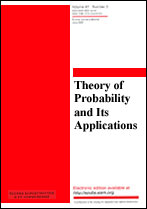|
This article is cited in 8 scientific papers (total in 8 papers)
Limit theorems for reduced branching processes in a random environment
V. A. Vatutin, E. E. D'yakonova
Steklov Mathematical Institute, Russian Academy of Sciences
Abstract:
Let $Z(n)$, $n=0,1\dots$ be a branching process evolving in the random environment generated by a sequence of iid generating functions $f_0(s),f_1(s)\dots$ and let $S_0=0$, $S_k=X_1+\dots+X_k$, $k\ge 1$, be the associated random walk with $X_i=\log f_{i-1}'(1)$, and let $\tau(n)$ be the leftmost point of minimum of $\{S_k\}_{k\ge 0}$ on the interval $[0,n]$. Denoting by $Z(k,n)$ the number of particles existing in the branching process at moment $k\le n$ and having nonempty offspring at time $n$ and assuming that the associated random walk satisfies the Spitzer–Doney condition $\mathbf{P}\{S_n>0\}\to\rho\in(0,1)$, $n\to\infty$, we show (under the quenched approach) that for each fixed $m=0,\pm 1,\pm 2,\dots$ the distribution of $Z(\tau(n)+m,n)$ given $Z(n)>0$ converges as $n\to\infty$ to a (random) discrete distribution which is proper with probability 1. On the other hand, if $m=m(n)\to\infty$ as $n\to\infty$, then to prove a conditional limit theorem for $Z(\tau(n)+m,n)$ given $Z(n)>0$, a scaling of $Z(\tau(n)+m,n)$ is needed by a function growing to infinity as $m\to\infty$.
Keywords:
branching processes in a random environment, Spitzer–Doney condition, conditional limit theorems, reduced process, most recent common ancestor.
Received: 27.03.2006
Citation:
V. A. Vatutin, E. E. D'yakonova, “Limit theorems for reduced branching processes in a random environment”, Teor. Veroyatnost. i Primenen., 52:2 (2007), 271–300; Theory Probab. Appl., 52:2 (2008), 277–302
Linking options:
https://www.mathnet.ru/eng/tvp173https://doi.org/10.4213/tvp173 https://www.mathnet.ru/eng/tvp/v52/i2/p271
|


|




 Contact us:
Contact us: Terms of Use
Terms of Use
 Registration to the website
Registration to the website Logotypes
Logotypes








 Citation in format
Citation in format 
